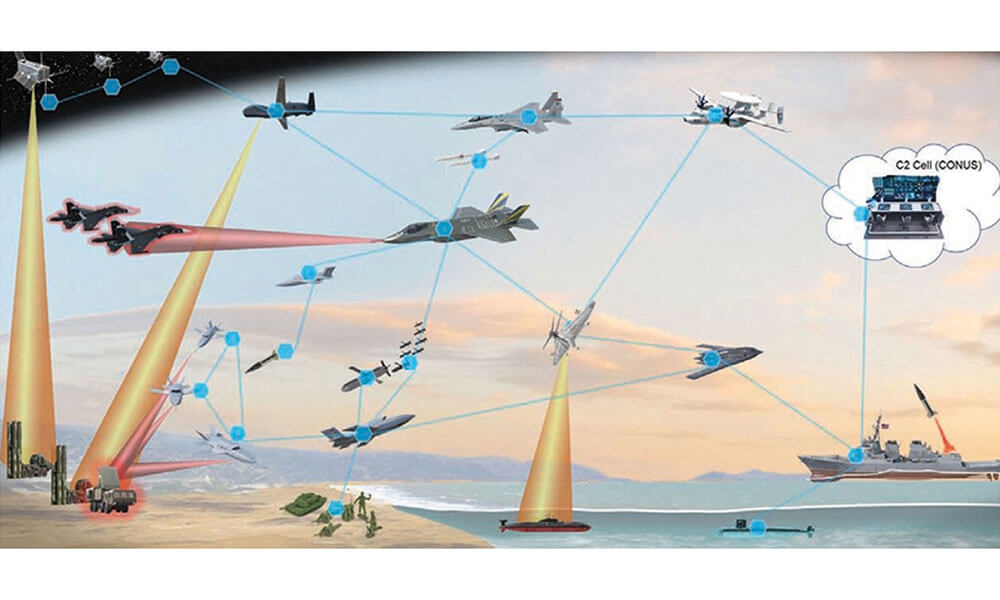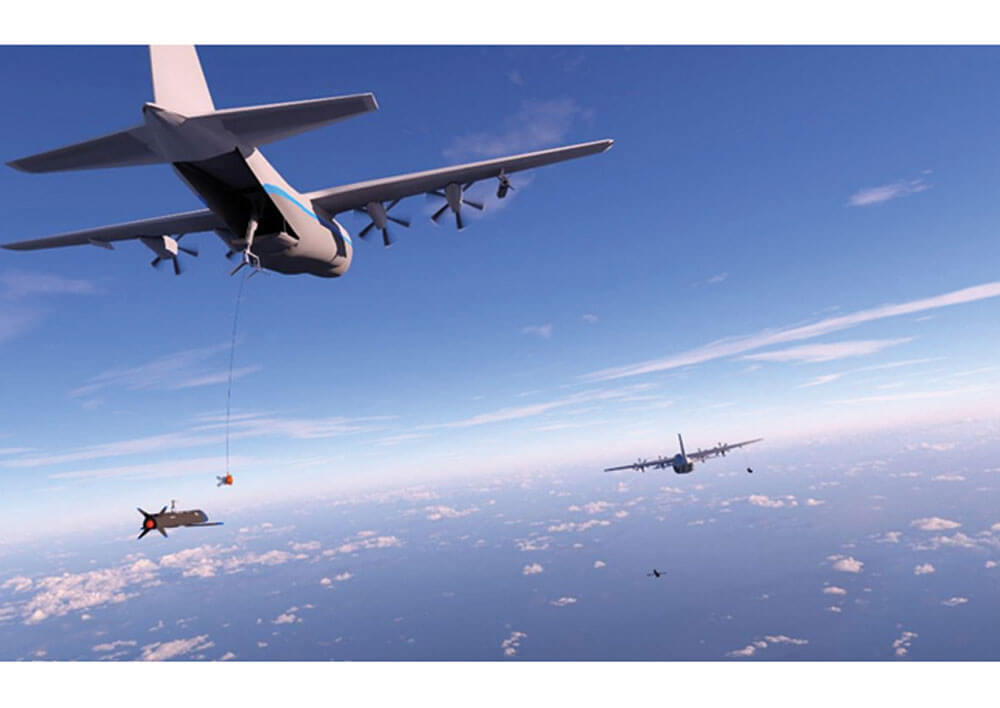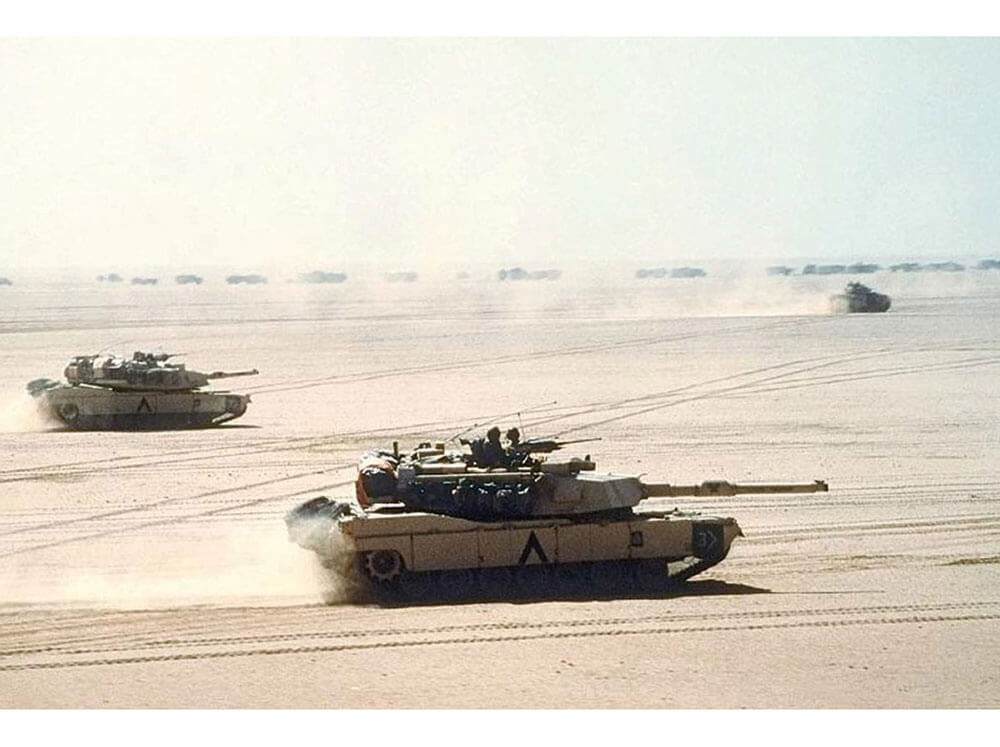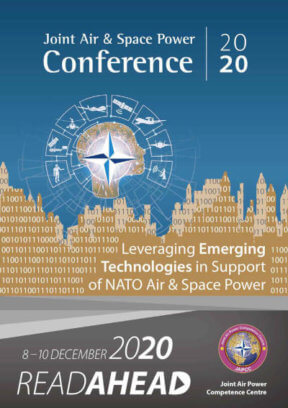Courtesy of Defense Advanced Research Projects Agency. Online Article at: https://www.darpa.mil/work-with-us/darpa-tiles-together-a-vision-of-mosiac-warfare.
The concept is called ‘Mosaic Warfare’. Like the ceramic tiles in mosaics, these individual warfighting platforms are put together to make a larger picture, or in this case, a force package.
The idea will be to send so many weapon and sensor platforms at the enemy that its forces are overwhelmed. The goal is to take complexity and to turn that into an asymmetric advantage, said Burns, who retired this past May (2018) as director of DARPA’s Strategic Technology Office (STO), handing the leadership baton off to Timothy Grayson.
‘When you attack in parallel across a wide front and you have distributed your sense-decide-and-act systems across a wide number of platforms, you can mass your firepower without having to mass your forces,’ said Burns, who is credited with getting talk about the Mosaic Warfare concept going in Department of Defense circles.
The DARPA hard problem is that today’s weapon systems are not built to function this way, Burns said. ‘They are more like pieces of a puzzle than tiles for a mosaic. They are exquisitely engineered to fit into a certain part of the picture and one part only. You can’t pull it out and put in a different puzzle piece. It won’t fit,’ he said.
One way Mosaic Warfare might work in a ground battle would be to send an unmanned aerial vehicle or ground robot ahead of the main ground battle force. It might spot an enemy tank. The unmanned system passes the coordinates back, which are then relayed to a non-line-of-sight strike system in the rear, which in turn launches its munitions and takes out the target.
‘It sounds like it should be something very doable, but it’s not right now,’ said Burns. ‘The interfaces are not made to communicate that kind of information and the Army doesn’t have air and ground vehicles that it can send forward,’ he added.
In the air domain, four F-16s might be going head-to-head with four rival jet fighters. However, in a Mosaic Warfare context, the US Air Force might also deploy four relatively inexpensive, somewhat expendable unmanned aerial systems ahead, each with different weapons or sensor systems. The combatant commander can treat these assets like a football coach who chooses team members and then positions them on the field to run plays. The added aircraft make the situation much more complex and can overwhelm the opponent’s decision-making.
‘It makes us more lethal and a lot more survivable,’ Burns said. But like a football play, things don’t always unfold as planned. The autonomous systems and pilots must be able to adapt, especially as the mission changes or unexpected events occur. And commanders in a Mosaic Warfare context would have the option of substituting new components and systems as parts of the initial mosaic composition are lost or they want to deploy a new tactic that requires different capabilities. John Waterston, a Program Manager in the STO and a Navy Reserve officer, said Mosaic Warfare may impose even more complexity on the adversary in the maritime domain, because it encompasses a diversity of environments: air, land, sea, and undersea. His charge now is to figure out how ships, submarines, aircraft, and unmanned systems all can work together to achieve a mission.
The organization and war-planning task almost surely would cross services as well, as combatant commanders mix and match assets. This fits into recent joint multi-domain battlefield concepts that Pentagon leaders have been talking about. These decision-makers acknowledge that going up against peer and near-peer competitors means having to protect forces from threats that could be coming at them from any domain – ground, air, space, sea, and/or cyberspace.
‘You want to leverage the best characteristics of different platforms,’ Waterston said. ‘It all gets down to where do you have access and capacity, and distributing them properly so all your eggs aren’t in one basket.’

‘We keep making awesome stealth fighters, or better submarines, and better and better unmanned systems,’ Waterston elaborated. ‘The thinking is: Why don’t we take simpler systems and then network them together, have them share, collaborate – sense their world in their own unique way – and put them together?’
Expendability (attritability in military speak) is key, Burns said. Conventional wisdom says U.S. forces shouldn’t fight in the open. ‘You’ll be killed. But if you have large numbers of expendable platforms, you can fight in the open,’ he said.
Again, the problem is that to create these systems of systems, they need to be linked together, Waterston said, highlighting the challenges here by pointing to recent reports that the new F-35A and the F-22, the Air Force’s two most sophisticated fighters, cannot stealthily share data.
Burns said the Strategic Technology Office’s goal is to create the interfaces, communications links, and the precision navigation and timing software – the technology backbone – to allow these exquisite systems to work together. On PowerPoint illustrations of battlefields, these communication links are often portrayed with lightning bolts. ‘One of our mottos is to make lightning bolts real,’ Burns said.
For a concept that welled up from DARPA, rather than from the services, think tanks, or war colleges, Burns said that Mosaic Warfare – a term coined by Burns and his former deputy director Dan Patt has been relatively well received during briefs to military leaders.
For Patt, Mosaic Warfare is ‘about an effective warfighting whole made up of many diverse and fluid pieces. How can you get all these little pieces all aligned toward a common objective without perfect communications and without planning everything in advance? It’s really hard. And that’s the idea of Mosaic Warfare.’
There is a direct line in thinking from the Chinese military strategist Sun Tzu and his treatise, The Art of War, to the Mosaic Warfare concept, said Patt, who is now CEO of Vecna Robotics and a non-resident Senior Fellow at the Center for Strategic and Budgetary Analysis, a Washington, D.C. –based think tank.

‘All ideas are present in Sun Tzu. But when these ideas are applied for the first time, it can give an asymmetric advantage,’ he said, citing Germany’s blitzkrieg tactics in World War II as an example, where an overwhelming force of armor, motorized infantry, artillery, and air power combined to force a local breakthrough that could then be exploited to continue the advance.
The so-called ‘Second Offset’ strategy following the Vietnam War, which matured into the air-land battle concept, called for airborne sensors and missiles that could work together to overpower a large Soviet army without having to escalate to nuclear warfare. Also known as Assault Breaker, the strategy is centered on the deployment of a system of systems, Patt said.
The problem with that approach was that it was ‘very brittle,’ he said. It took years of engineering to ensure one system could link with another system.

‘They brought together a couple pieces and it did offset Soviet capability,’ Patt said. ’But it wasn’t a particularly easy or scalable approach. There were a lot of challenges to make that work fluidly. Today, it is still difficult for systems to share information with each other.’
‘There has to be a better way. And the technologies DARPA is developing are about that better way,’ Patt said.
Another benefit of Mosaic Warfare is that it makes the kill chain more resilient, Patt said. The sense-decide-act decision loop has also been around since the days of Sun Tzu, or longer, he said. More recently, the U.S. military refined the idea to the observe-orient-decide-act decision cycle, or OODA loop.
If a commander could unbundle those functions, everything that has a sensor could be connected to everything that can make a decision, and then to anything that can take an action. ‘That is really powerful, because mathematically, you expose all the possible combinations and create thousands upon thousands of connections,’ Patt said. Those thousands upon thousands of connections force an enemy to contend with many possible combinations of attacks as well.
‘That gives resilience. It doesn’t matter what the enemy does, the [blue force] still has options for completing a kill chain.’
Many of the platforms that could be used for Mosaic Warfare already exist. Nevertheless, work continues on developing unmanned platforms that could be applied to the concept.
Waterston said the next step for Mosaic Warfare, and an all-important one, will be demonstrating how it all works.
‘Operational commanders aren’t going to use these systems if they haven’t been tested and demonstrated,’ Waterston said. ‘They have to trust them.’








